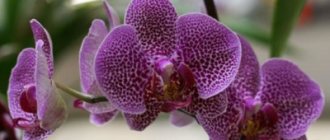A tiny rose in a flower pot is the dream of many house plant lovers. The delicate aroma of flowers and the grace of the branches will not leave anyone indifferent. But it is believed that growing indoor roses is very difficult.
How difficult is it to care for a miniature house rose? It is no more difficult than caring for an ordinary garden one, if you provide it with the same conditions. The rose is not a tropical plant or a desert flower; it requires a temperate climate and cool wintering.
Indoor rose (genus rose, or wild rose (Rosa)), belongs to the Rose family (Rosaceae). Potted roses are compact bushes up to 35-45 cm. Currently, several hundred varieties of miniature roses have been bred, and the assortment is constantly being replenished. They are conventionally divided into groups Mini-Flora, Miniature and Polyantha.
The flowers of indoor roses are small, very decorative, can be fragrant or odorless, and come in a variety of colors.
Caring for indoor roses varies depending on the season. As in natural conditions, it requires a cold winter. Too high a temperature in summer is also harmful. In the warm season, these plants are recommended to be taken out into the open air.
Flowering miniature rose bushes are also available for sale in winter. It is very beautiful, but after the flowering period a dormant period is required to allow the plant to rest. And in this case, the dormant period shifts to spring - the time when in nature plants wake up and develop. Lack of such rest can lead to the death of the rose.
Rose patio mix: care at home
This plant is quite whimsical and demanding. There are situations when a rose, having found itself in new conditions, begins to wither, lose flowers and buds, turn yellow, and dry out. It is often susceptible to pest attacks. In order for the flower to live long and please the owner with a beautiful and healthy appearance, rose owners must follow the recommendations for caring for it.
Caring for a patio rose at home involves providing the plant with the correct regime of watering, lighting, fertilizing and replanting.
Rose transplant
When purchasing a patio rose, you should first think about replanting it. The fact is that in stores, even specialized ones, such a flower is often kept in poor conditions: poor-quality pot, depleted soil, etc. Therefore, as soon as the rose finishes flowering or at least slightly gets used to the new living conditions, it should be replanted.
You need to choose a pot for transplanting that is slightly larger than the store-bought one. Before transplanting, it should be thoroughly washed and disinfected to avoid infection of the plant. There should be drainage holes at the bottom of the pot. Expanded clay is poured into the pot, and 2-3 cm of soil should be poured on top. It is advisable to purchase special soil for patio roses. If the owner makes the soil himself, then a mixture of peat, sand and turf works well.
Then the patio rose is carefully removed from its pot, and, being careful not to destroy the earthen ball, is lowered into a new pot. The voids are carefully filled with prepared soil. The soil needs to be watered abundantly with settled water.
If everything is done correctly and the rose was not initially sick with anything, then soon after the transplant it will take root and begin to develop well.
In the future, it is advisable to replant the rose every year, at least in the first few years. The transplant conditions remain the same.
Description and characteristics
Having figured out what a patio rose is, it will be interesting to learn about its appearance and features.
This type of rose looks like a small lush bush with a lot of flowers. These bushes are planted both in open ground and in separate pots, which allows you to keep them at home and decorate rooms, balconies, loggias, and verandas with them. The height of the plant is 40-50 cm. The flowers are from 2 to 5 cm in diameter.
A nice feature of the patio rose is that flowering can last for quite a long time. This is facilitated by pruning the plant.
The variety of varieties is impressive. The term "patio mix rose" is often used to describe this rose. The word “mix” in this case means great variability in the appearance of the plant. Another name used for some varieties is patio hit mix rose. There are at least 2000 varieties of this plant. The colors include all kinds of shades of red and pink, yellow, white, lilac, and color combinations.
As breeders continue to work on developing new varieties of patio rose, we can expect the most unusual shades to appear in the future.
Rosa Patio: general cultural information
Rose Patio is a dwarf variety of this majestic culture, the representatives of which form a separate subgroup. This culture came to Europe in the second half of the 19th century. Decorative miniature varieties of roses were taken from China, which scientists decided to cross with floribunda roses. The main selection work was carried out thanks to the Irish botanist Patrick Dixon.
Rose Patio
At the end of the 50s, one of the most famous varieties of the Patio rose, Meteor, was bred. It is worth noting that today breeding experiments to develop new varieties of Patio roses are still ongoing. Hybrid tea roses took part in crossing with miniature plants, after which it was decided to breed a dwarf rose using a polyantha variety, which was taken as a basis.
Note! In 1980, the Patio Mix and Swept Magic roses received a well-deserved award - Best Rose of the Year, after which American scientists decided to separate these flowers into a separate group.
The standard rose Patio was named after the cozy courtyards in Spain or Italy, which are usually called patios there. To decorate such courtyards, various flowers were used, which were planted in containers or pots. This culture also has another name - rose miniflora, but in many European countries it has not taken root. As for the non-scientific name, it is the “border” rose.
Varieties of indoor plants
- Korsnoda
The bush is compact, maximum size is 60 cm in height. The flowers are double, white and cream in color. Flowering is long and abundant.
- Rose spray Macarena
The bush is compact, the inflorescences are large. The foliage is glossy. The blooming flowers are rosette-shaped and light yellow in color with a brighter center. Over time they acquire a pink tint.
- Pink Flash
Winter-hardy species. Bush 50-60 cm high. Feature: marble color. The flowers are pink in color; the petals have light pink stripes, which change color to a richer pink in the cold.
Use in landscape design
- Typhoon
Bush up to 70 cm. The flowers are small, the color is red with shades of orange. More often grown in pots than in open ground.
- Patio hit
The bushes are compact, 30-40 cm in height. The flowers are semi-double or double, lush, of different colors.
Rose Patio Hit, which is easy to care for at home, is perhaps the most popular variety of Patio in Russia. Moreover, both experienced flower lovers and beginners are trying to grow it.
Description of varieties
At the end of the last century, Patio roses were separated into an independent group. Despite this, in some catalogs these plants are still classified as varieties such as miniature or Floribunda.
Patios were obtained as a result of breeding work by crossing border and low-growing varieties. The varieties Marlena and Meteor were the very first to be bred.
These flowers are characterized by short stature. However, among the Patio there are also taller representatives. They differ from other species in the shape of the leaf blade and flowers. For example, the flowers and leaves of Patio are smaller than those of Floribunda, but larger than miniature ones. Flowers come in a variety of shapes and shades. They can be simple or terry. The largest specimens reached 5 cm in diameter.
The bush has compact dimensions. It grows up to 55 cm in height. Often such plants are grown in trunks. Here you can achieve a height of 1 m from them.
Representatives of this variety are often used by designers to create landscape displays.
Soil and pot
For homemade rose Mix you need special soil, which can be bought at a flower shop. To make your own substrate, mix turf soil with peat and sand in a 2:2:1 ratio. But be sure to disinfect the mixture before planting. Otherwise, the plant will suffer from pathogenic microbes living in the soil. Before the event, add some granular fertilizer to the mix.
How to buy furniture in China online
Rose Mix takes root better in ceramic pots with a glazed surface. Their dimensions should exceed the volume of the roots by no more than 2–3 cm. And the pots should also have drainage holes. Before the event, it is advisable to soak such containers in warm water for 2 hours. Then the material will be saturated with moisture and will not then draw water out of the soil.
Patio roses: varieties and types
BabyMasquerade. This is an unpretentious variety with a weak aroma, resistant to frost and drought. Looks good in flower beds and pots.
Baby Baccarat - France (Meilland). These roses look beautiful in pots in front of the house. They are bright and memorable.
LavenderJewel - USA (Moore) 1978. This is one of the most beautiful miniature roses with double mauve flowers. It blooms for a long time, but after the final opening the flowers fade to a lilac hue.
Korsnoda. A very frost-resistant white rose, resistant to many diseases.
MimiEden – France (Meilland). A wonderful two-tone rose, the petals are ivory on the outside and pink on the inside. There are 8-10 flowers in the brushes, which bloom one by one.
Lydia - Holland (Interplant) 1990. Light pink, non-double, the middle is visible through the petals.
Petito. Yellow rose with red stripes, unpretentious, disease resistant.
Rumba – Denmark (Poulsen). A very beautiful variety, bred in 1959 and still popular among rose lovers.
ApricotClementine – Germany (Evers). A rose with large apricot flowers will decorate any garden and home.
Another name for these roses is “border roses.” Patio roses, varieties and types of which continue:
- AnnaFord. This rose has red-orange flowers with a yellow eye.
- Gentle Touch. This rose is characterized by pale pink flowers.
- Honeybunch. This is a variety with densely double flowers, reminiscent of the color of honey and a fragrant aroma.
- StrawberryFayre. Red and white striped flowers with a delicate scent. This rose has golden yellow flowers with slightly curved petals
- Sunseeker. Scarlet flowers with a yellow center
- SweetMagic. The flowers of this rose are of unusual color: golden yellow with orange streaks
Patio roses, their various varieties and types, will always attract attention with their endurance and extraordinary beauty of endlessly blooming inflorescences. Without a doubt, they can be called the little treasures of your garden!
What to do after purchase?
Before sale, the Mix rose is placed in a peat substrate. This soil retains moisture for a long time, which reduces the need to care for the plant in the store. But such soil is not suitable for long-term cultivation. Therefore, after purchase, it is important to replant the crop.
Start the event when the rose has acclimatized to your conditions. Typically this takes 10–12 days. At this time, water the flower regularly, preventing the soil from drying out. And don’t forget to spray the foliage periodically.
Rose care mini turbo ed. What is Rose Mix
These are small plants of various colors, growing 30-50 cm in height. Medium sized flowers with a light scent
The miniature rose is whimsical, loves attention and care, which is the same for all Mix varieties
First of all, the plant needs good watering
This is especially important during the flowering period. Use water at room temperature
In summer it is necessary to water twice a day; by autumn the amount of watering should be reduced. In addition, the rose needs to be sprayed. In winter, you can stop watering altogether, leaving only spraying.
Lighting and temperature play an important role in caring for Mix roses at home. To stimulate continuous flowering, the plant constantly needs light. To ensure this, you can use special lamps or daylight devices.
In order for the flower to develop well, the room temperature must be +18 degrees. Its fluctuation by 5℃ in any direction is acceptable. In a cold place, the roots may become sick; in a very warm place, especially with dry air, the flower petals will begin to dry out and fall off. In the summer, a good place for Mix roses is a balcony, protected from drafts and direct rays of the sun.
When caring for a plant, it is worth remembering about feeding. It is best to fertilize when the flower is actively growing. Good results during fertilizing can be obtained by alternately using mineral fertilizers and organic matter. It is recommended to feed the plant in the afternoon, after moistening the soil. If the flower is sick or has recently been transplanted, it cannot be fertilized.
An integral part of care is transplantation. Only the purchased flower needs to be replanted immediately. A bush with overgrown roots also needs a new large container. You can start replanting roses at any time of the year, but it is better in the fall. The soil for replanting should be loose and moist. It is recommended to purchase soil with all the necessary nutrients in a specialized store. To replant a plant you need:
- prepare a new pot larger than the previous one by 2-4 cm in diameter and 5-7 cm in height;
- Place 1cm of drainage on the bottom, or 3cm if there are no drainage holes;
- pour in some of the specially purchased soil. You can use garden soil mixed with fertilizers and moss;
- water the flower before replanting;
- after the soil is completely moistened, pull it completely out of the pot;
- transfer to a new container without removing the soil from the roots;
- cover with soil and compact lightly;
- There is no need to water the flower, but it is worth spraying the leaves.
Roses need to be pruned twice a year. In autumn to form a bush shape. Healthy stems are pruned so that 4-5 buds remain on each, weak stems - 2 buds. In spring, faded leaves and flowers and faded buds are removed to prolong flowering.
Transfer
To make the plant take root easier and faster, cut off all the buds without pity before the event. Don't worry, after a while the culture will release new ones. Transplant a miniature rose in this way:
- At the bottom of the container, place a centimeter layer of drainage consisting of pebbles, brick chips or expanded clay. Sprinkle it with a small layer of soil.
- Carefully remove the rose from the pot without destroying the earthen ball.
- Place the flower in a new container and fill the voids with soil. To compact the soil, lightly tap the sides of the pot.
- Spray the foliage with warm water, but do not water the flower.
- After transplanting, place the crop in a shaded area.
- The next day, water the soil and move the pot to a permanent place.
A similar event will need to be carried out in the spring, as the home rose Mix grows.
Landing
It is recommended to plant seedlings in open ground in early spring. Before planting, it is recommended to soak the root system, if it is open, in water for two to three hours.
For planting, it is recommended to choose a sunny and open area. The hole should be about 45 cm in depth and in diameter so that there is room for the root system in it. At the bottom of the hole it is necessary to make a drainage layer: small pebbles (pebbles, expanded clay or broken brick) are placed at the very bottom, and a little sand is sprinkled on top.
It is recommended to put organic fertilizers on top of the drainage. You can use dry leaves, grass or rotten wood. It’s a good idea to put a little manure at the bottom of the hole.
The seedling is planted in a hole and covered with the top layer of soil. The soil is well compacted around it.
Important! If the rose seedling was purchased in a container, then it needs to be replanted. Replanting after purchase is a necessary and simple process . Initially, you need to carefully remove the rose from the container. The landing process itself is no different from the above.
It is recommended to make a small depression for water next to the rose bush. After the plant has been planted, it needs to be watered. One plant requires about 8 liters of water. For irrigation, you need to take warm water that has been heated by the rays of the sun. It is advisable to use rainwater. When using tap water, it is recommended to let it sit for a few days so that all the chlorine is released.
History of appearance
The appearance of this plant was preceded by a number of discoveries in the field of breeding. In the second half of the 20th century, floribunda roses were developed. They differed in that the buds and flowers were collected in clusters. Among the floribunda roses, a group of dwarf roses stood out, but at that time they did not have a separate name. It was not until 1980 that a name for this group was proposed. The word "patio" in Spanish means an internal courtyard of a living space, fenced on all sides. Patios are usually small, cozy and beautifully decorated with flowers. It was this word that gave the name to a new type of flower. Photos of patio roses are posted later in the article.
Boys Brigade
The rose flowers of this variety are small, semi-double, collected in large inflorescences. The petals are creamy inside and bright pink at the edges. The bush is lush and highly branched, low. The variety is profusely flowering.
Subvarieties and their photos
Parade
Low plant (40 – 45 cm). Pleases with lush flowering for 5 - 6 months. Then follows a two-month break. Best adapted to home conditions.
Patio hit
The rose belongs to the floribunda group . The stem length is 50 – 55 cm. Large flowers can be of different shades, they even have two-color petals. Blooms long and profusely.
Mini
Dwarf plants (up to 40 cm). The buds can be either small or large in size.
Danica
A small plant about 30 cm high. The size of the petals in a bud is approximately 3 - 5 cm. Their color may vary.
Varieties of garden miniature roses with descriptions and photos
Below are the names of varieties of miniature roses with descriptions, photos and recommendations for growing.
Varieties of garden miniature roses, popular all over the world:
"Los Angeles"
A dark orange classic rose with flowers 4-5 cm in diameter. Particularly decorative due to the intense color of the flowers. Flowering is abundant. Bush height: 30-40 cm.
The quickly woody shoots grow straight, producing up to 80 flowers on each. The leaves are compound, consisting of 5-7 leathery, shiny leaflets, ovoid, finely serrated along the edges, in most varieties they are dark green, but there are varieties with bronze-brown foliage or light green with dark veins. The flowers are small with many petals.
They do not retain color during the flowering period: the bush simultaneously bears lemon-yellow, coral-pink, crimson-crimson flowers, which makes the plant extremely elegant.
"Clementine"
Flower diameter - 5 cm.
As you can see in the photo of this variety of decorative roses, the shade of the flowers surprisingly beautifully changes from pink to apricot-orange:
The height of the bush is 40-60 cm. The bushes are compact and strong. The distance between plants is 30-35 cm. The variety is resistant to powdery mildew and black spot. Repeated flowering. It is especially recommended to grow in small rose gardens.
In temperate zones, the buds do not bloom for a long time; when half-opened, they take the form of noble large-flowered roses. In hot conditions, buds appear on the 4th-5th day and the entire mouth is covered with bright, beautiful flowers throughout the summer. Cut flowers stand in water for 7 - 9 days without losing their decorative properties; in some varieties they have a delicate aroma.
"Hummingbird"
A profusely blooming rose 25 - 30 cm high with flowers up to 3 cm in diameter. The flowers are yellow-orange, slightly double, with original petals spread out like hedgehog spines. The color fades in the sun. The leaves are shiny and leathery.
"Jewel"
The buds are oval, pointed. The petals are dark red, with a yellow bottom; when flowering, they bend downwards and fade slightly. Flower with a high center, medium (3-5 cm), densely double (up to 100 petals), slightly fragrant.
It develops in small inflorescences and singly, on thin, durable peduncles. The leaves are elongated, dark green, leathery, shiny, young leaves and shoots are dark red. Thorns are rare. The bushes are compact. Flowering is moderate all season. Flowers last a long time.
"Lavender"
At first they have the shape of a hybrid tea rose, but when they open up they look like a miniature floribunda. The color is a beautiful, clean lavender with hints of lilac and purple. The number of flowers on the stem is 1–3 pieces. The flower size is 4-5 cm in diameter. The height of the bush is no more than 40-50 cm.
They can also be used to decorate walls, balconies, and arches.
“Orange Jewel” - salmon-orange flowers, large, densely double, noble in shape, do not fade for a long time. The bush is strong, compact, and grows easily. Height 30 cm.
“Amulet” - flowers of a rich pink-red color, large, densely double. The foliage is green. The bush is dense, quickly growing, healthy. This variety is famous for its charming flowers, as well as its abundant and long-lasting flowering. Height - 50 cm.
Look at the photo - miniature roses look very decorative:
The best varieties of miniature roses today are considered to be the following:
"Little Baccarat" is a low (up to 25 cm) bush, spreading. The leaves are shiny with a bronze tint. The flowers are semi-double, red-crimson with a white center. They have a pleasant smell.
"Baby Baccarat" - distinguished by the ideal shape of the flower, velvety red, almost black.
“Pomegranate” is a densely leafed bush, durable, shiny, dark leaves, abundant flowering. The flowers are large (up to 5 cm in diameter), ideally shaped, crimson-red.
"Rosemary" - with light silver-pink flowers and a red eye - with small double flowers of orange color.
Humidity and flower watering regime
Rose requires high humidity. Therefore, caring for a patio rose involves daily spraying the leaves of the plant with water at room temperature. The water should be clean and not cold. It's a good idea to place a humidifier in the room.
Patio roses need to be watered regularly. You can usually navigate by the soil in the pot: if it is dry, the plant needs to be watered. It is advisable to drain excess water from the pan to avoid rotting of the root system.
Errors in care
- Dry air can cause leaves to dry out, buds to fall off, and shoots to change color. Proper regular watering, spraying, showering will help.
- Pests . They damage the shoots and root system, the plant loses its leaves and stops blooming. Treatment with special preparations and bathing of stems and bushes will help.
With proper care, an indoor mixed rose can delight its owners with abundant and long-lasting flowering all year round. Knowing the basic requirements for the maintenance of this plant, achieving such a result is not very difficult.
Preparation of soil and planting material
Many gardeners prefer the miniature Patio rose largely because this plant is unpretentious, and it also takes root well, despite the conditions. The crop can be planted and grown in special containers, in pots on windowsills, or in open ground. Before planting begins, high-quality preparatory work must be carried out. So, preparation consists of two key points, namely:
- choosing the appropriate variety and seedlings of the Patio rose.
- choosing a site for planting.
How to make furniture with hiding places with your own hands: all the secret places
After the planting material has been purchased, the seedlings must be washed under warm water to eliminate possible bacteria and microbes. If you plan to plant at home, it is recommended to transfer the seedlings to a large container and then send them to the greenhouse until the optimal time for planting arrives.
Rose Patio actively grows and develops in those areas that are sufficiently illuminated by sunlight, since only the sun can provide bright and abundant flowering. When planted in open ground, seedlings must adapt, so they must be temporarily protected from direct sunlight.
Is it possible to plant Patio roses in open ground?
Peony roses - what kind of variety are they?
Patio roses can be grown in open ground. With proper care, the bushes will look even better than in pots.
How and when it's done
In central Russia, it is better to plant a domestic rose in the garden in the spring, after the return frosts have subsided.
Selecting a location and preparing soil and plants
Roses grow well in slightly acidic or neutral soils. The landing site should be selected taking into account the requirements of the culture, namely:
- deep groundwater;
- absence of drafts;
- illumination by sunlight in the morning and evening hours.
The latter is very important for the rapid evaporation of night dew, which serves as a prerequisite for the appearance of fungal infections.
How to care for a flower outdoors
Homemade roses should be planted in the garden in the spring, at a distance of 30-50 cm from each other.
Garden Patio
Caring for an outdoor flower is no more difficult than caring for an indoor one. It also needs regular pruning, watering and feeding. Pruning is carried out before sap flow begins. Crown formation is combined with sanitary cleaning. During the summer, faded buds and substandard shoots (weak, thin) are removed. Starting from the second half of August, pruning stops.
Important! At the beginning of the growing season, nitrogen fertilizers are used, then potassium-phosphorus fertilizers.
Features of wintering plants
Preparation for winter begins in late autumn. The step-by-step actions look like this:
- Free the bush from all damaged branches, clean it from pests, cure diseases, and dispose of diseased prunings.
- Cover the plant with high mulch (peat, humus, sawdust, dry leaves, straw) and cover it with any covering material. It wouldn’t hurt to cover it with spruce branches and regularly sprinkle it with snow.
- With the onset of thaws, gradually free the bush from its shelter. It can be completely removed when the return frosts stop.
Temperature
The capricious rose Mix does not tolerate both heat and cold. In summer, the optimal temperature for the crop is +20…+23 °C. In winter, temperatures should not drop below +15 °C. For normal development, the flower needs fresh air. Therefore, ventilate the room in which you grow your rose more often. In summer, move the pot to the balcony or garden. But choose places protected from the wind with diffused light.
At any time of the year, protect the flower from drafts, and when ventilating the room, take the pot to another room. And also do not grow indoor roses near radiators or heating devices. If this is not possible, then build a screen of foil or cardboard between the pot and the heat sources.
Description
A tiny rose in a flower pot is the dream of many house plant lovers. The delicate aroma of flowers and the grace of the branches will not leave anyone indifferent. But it is believed that growing indoor roses is very difficult.
How difficult is it to care for a miniature house rose? It is no more difficult than caring for an ordinary garden one, if you provide it with the same conditions. The rose is not a tropical plant or a desert flower; it requires a temperate climate and cool wintering.
Indoor rose (genus rose, or wild rose (Rosa)), belongs to the Rose family (Rosaceae). Potted roses are compact bushes up to 35-45 cm. Currently, several hundred varieties of miniature roses have been bred, and the assortment is constantly being replenished. They are conventionally divided into groups Mini-Flora, Miniature and Polyantha.
The flowers of indoor roses are small, very decorative, can be fragrant or odorless, and come in a variety of colors.
Caring for indoor roses varies depending on the season. As in natural conditions, it requires a cold winter. Too high a temperature in summer is also harmful. In the warm season, these plants are recommended to be taken out into the open air.
Flowering miniature rose bushes are also available for sale in winter. It is very beautiful, but after the flowering period a dormant period is required to allow the plant to rest. And in this case, the dormant period shifts to spring - the time when in nature plants wake up and develop. Lack of such rest can lead to the death of the rose.
Accommodation requirements
Patio rose prefers cool temperatures and does not tolerate heat and stuffiness. Therefore, in summer it can be placed on the balcony or veranda. This plant loves light, but it is strictly undesirable to allow it to be exposed to direct sunlight. Leaves may get burned, begin to turn yellow and fall off.
Drafts are no less dangerous for her. If the rose is kept on a window, then in cool and cold weather it is necessary to insulate the windows so that the plant does not freeze. It is better to place the rose on a southwest or southeast window.
During months when daylight hours are short, a fluorescent lamp can be used to provide the desired level of illumination.
Care and conditions of detention
Lighting.
All roses are light-loving plants. The best windows for roses are south, southeast and southwest. In the summer, indoor roses on southern windows suffer from the heat, but by this time they are usually taken out into the open air. If this is not possible, then you need to move it to another window or shade it.
Temperature.
In summer the temperature should be moderate, in winter – cool. Indoor roses at home suffer more not from too high air temperatures, but from overheating and overdrying of the substrate in the pot, and in winter from hypothermia of the roots. Cold drafts in winter are harmful, but small daily temperature fluctuations are beneficial.
Air humidity.
Too dry air leads to drying of leaves and the appearance of pests. Roses prefer moist air. But if the plants are on an open balcony or in the garden, then they do not need daily spraying. It is advisable to have a warm shower once a week - this summer rain will benefit them.
Watering.
Miniature roses are very sensitive to overwatering, especially in winter and spring when there is no growth. When young buds appear on the plants, watering is increased slightly, and when enough leaves have already bloomed, then water more. In summer, indoor roses require abundant watering. With the onset of autumn and the cessation of flowering, watering is reduced.
Water for irrigation should be left standing for at least a day, at room temperature or a little warmer. It is very harmful to water with cold water.
Lighting
Rosa Mix is a light-loving plant. But the beauty is harmed by direct rays of the sun, so it is better to grow it near an eastern or western window. On the northern windowsill, the crop will not have enough light, and it will drop its buds and foliage. If you grow a flower near a south window, be sure to shade the foliage during the midday hours. Otherwise, the plant will get burned, which will affect its health and decorativeness.
Rose propagation
Cuttings are excellent for propagating this plant. This method is not only quite simple, but also useful: pruning a rose is an important component of its beauty and health.
To do this, several shoots are cut off from the plant. The cutting areas can first be dipped in “Kornevin” or any other root growth stimulator. The shoots are placed in water. After some time, roots will appear on them. When they have grown and become strong enough, you can plant the cuttings in the ground.
Growing problems, diseases and pests
What diseases can attack roses?
- powdery mildew;
- rust;
- rot;
- leaf spotting.
Pests may appear:
- spider mite;
- aphid;
- leaf roller
For prevention in the spring, the plant is treated with fungicides or a solution of copper sulfate.
Diseased or infected plants are treated with special preparations: Fitoverm, Karbofos, Hom, Topaz. It is also possible to treat with wood ash or horsetail decoction.
Patio roses are not dwarf varieties, but with their miniature beauty they can decorate any garden as a reward for regular care. Flowers look especially beautiful on the windowsill, surprising random witnesses. Caring for the Patio is not too difficult, so lovers of indoor and garden plants should definitely pay attention to this variety.
How to choose rose varieties for growing in a container
Not all varieties of roses are suitable for container growing, especially if these are not large containers that will be placed in the garden or flower garden, but small containers for a balcony or terrace.
We definitely do not consider large, actively growing roses like ramblers as container plants. Shrub roses will also feel more comfortable “in freedom”, and although they have several compact varieties, this is not the best choice for a flowerpot.
So it is best to consider less whimsical and demanding roses - miniature, ground cover, hybrid tea and patio. In any case, remember that the conditions for roses in containers are close to those in open ground, so you need to choose the hardiest varieties from trusted breeders.
Some well-proven flowering rose varieties for containers: Chilie Clemtntine, Biedermier, Goldjuwel, White Babyflor, Sugar Baby, Mandarin, Ninetta, Hobby, The Fairy, Yellow Clemtntine, Lavander Ice, Honeymilk.
Trimming
If you want to get compact and lush bushes of the domestic rose Mix, then you cannot do without formative and sanitary pruning. At the end of winter - beginning of spring, remove all weak, tangled and damaged shoots. Leave 4-5 strong branches on the bush, each with 3-5 “eyes”. Make sure the middle remains free.
In summer, be sure to remove faded buds. They take away strength from the plant, and also look unattractive. Trim the buds from 3-4 cm of the stem. In autumn, shorten the branches, leaving 3-4 buds on each shoot.
English roses: varieties with photos and descriptions
Varieties of English roses do well in our climate. They are relatively undemanding to sunlight. Dampness is also tolerated more easily by many other roses. See further on the page for varieties of English roses with a description from which the general characteristics will be clear. A description with a photo will help you choose English roses, where you can see with your own eyes the beauty of these flowers.
'Abraham Darby' (Abraham Derby); scrub, English rose; David Austin, England, 1985, zone 6.
One of Austin's most popular roses. The enchanting aroma of large, up to 15 cm in diameter, apricot-pink flowers captivates. The flowers are densely double, heavy, so they look down, the middle is densely colored, the intensity decreases towards the edges. The rose requires support. The height of the bush is 1.2-1.5 m. Disease resistance is good.
Further, English roses of this variety are shown in the photo in bloom.
'Ballerina' (Ballerina); scrub, a musk rose hybrid; Benthal, England, 1937, zone 6.
Anyone who sees this rose for the first time thinks that it is a phlox. The flowers of this variety are light pink, small, 2-3 cm in diameter, but there are from 30 to 50 of them in the inflorescence. The flower has five petals. The bush is tall, in some years up to 1.5 m, and up to 1.5 m wide. This is a very hardy variety. Light cover required.
'Compassion'; climbing rose; Harkness, England, 1972, zone 6.
The flowers are double, beautifully shaped, 8-10 cm in diameter, very fragrant, solitary or in inflorescences. The leaves are shiny and healthy. The bushes are powerful, spreading, 2.5 m or more in height and 1-1.2 m wide. Flowering is abundant and repeated.
'Grace' (Grace); floribunda, English rose; David Austin, England, 2001, zone 6.
This rose has a wonderful peach color of petals, lightened towards the edges, and a delicate scent of real peach. The flower looks like a dahlia. In inflorescences there are 3-7 flowers. A fast-growing rose, reaches a height of 1.2 m and a width of 1 m. Flowering is continuous. The plant is disease resistant.
'James Galway' (James Galway); English rose; David Austin, England, 2000, zone 6.
Double flowers with a diameter of 10-12 cm, soft pink-lilac in the center, and paler at the edges. The petals are folded very tightly. The flowers point upward or to the side, which is not so common in English roses. Very subtle rose scent. The bush is fast growing, almost without thorns. Can be grown as a scrub rose up to 1.4 m high and as a climbing rose up to 2.5 m high.
'Jubilee Celebration' (Jubilee Celebration); Schrub, David Austin, England, 2002, zone 6.
This rose was named in memory of the Queen's Golden Jubilee, so it is by definition one of the best roses. The flowers are 10-12 cm in diameter, rich salmon-pink in color with a golden tint on the back of the petals, and smell of fruit, lemon and fresh strawberries. The rose blooms profusely and for a long time, and is resistant to diseases. The bush is vigorous, beautifully shaped, up to 1.2 m high.
'Rhapsody in Blue' (Rhapsody in Blue); floribunda; Cowlishaw/Warner, England, 2002, zone 6.
The rose has an unusual violet-purple color. The flowers are 5-6 cm in diameter, simple, with a white eye and yellow stamens, do not fade in the sun. The bush is strong, straight, 1.2-1.5 m high. It blooms all summer. Blooms well in almost shade.
Rest period
During the cold season, the rose enters a so-called dormant period. Flowering ends and some of the leaves fall off. During this period, it is advisable to provide the patio rose with a comfortable winter. To do this you will need:
- Transfer the plant to a cool room, preferably with a temperature no higher than +15 degrees.
- Reduce watering, spraying and fertilizing.
- Be sure to trim the plant, shortening the length of the branches by about a third.
If you correctly follow all the recommendations for maintaining and caring for a patio rose, including instructions regarding wintering, then in the spring the plant will delight the owner with rapid growth and the appearance of a large number of buds.
Apricot Clementine
The variety blooms continuously for a long period of time, constantly forming new inflorescences. The flowers are densely double, medium-sized, and the color ranges from pink to apricot. Bushes up to 0.6 m high, compact.
Lady Bombastic
A profusely blooming rose, it is suitable both for decorating flower beds and for creating flower arrangements, while it blooms on large brushes, which already form a whole bouquet. A unique rich pink color with a light center. Densely double, small flowers abundantly cover the bush. Repeat-blooming variety with a long flowering period.
Yellow peony roses
Thanks to the work of English breeders, peony roses with yellow petals were born. Such varieties are loved by Russian flower growers for their unpretentiousness and resistance to sudden temperature changes.
Golden Celebration
This wonderful variety is distinguished by lush flowering and large inflorescences with a diameter of up to 16 cm. Flowers are collected in groups of 3-4 pieces. Honey-lemon roses exude a pleasant aroma.
The peony bush rose reaches a height of 1.5 m. The thorny shoots are curved and covered with dark green bark. The variety is resistant to sudden temperature changes and diseases. Flowering lasts throughout the entire warm period.
A wonderful plant with lush flowering
Graham Thomas
The variety is young, bred in 1983. Thanks to its double fragrant flowers, the plant has gained great popularity among gardeners. The inflorescences are large, 10-12 cm in diameter. The petals are canary-colored with a peach tint. The rose bush blooms from the beginning of summer until the first frost. Inflorescences are collected in brushes of 3-5 pieces.
In regions with cold climates, the rose bush reaches 1.5 m; in southern cities, the plant grows up to 3 m. The variety is resistant to temperature changes and has strong immunity to diseases.
Important! Graham Thomas variety - the best variety of D. Austin
The variety is resistant to temperature changes
Main varieties
Mini roses were brought to Europe at the beginning of the 19th century from East Asia, but at that time these varieties were rare. They began to be grown on an industrial scale not so long ago, with the advent of modern cloning technologies. Today, thanks to the efforts of American, Spanish, but mainly Dutch breeders, a huge number of forms and varieties of miniature roses have appeared. The following 4 varieties are considered the most popular in home culture.
Mini mix
This group includes many different varieties of dwarf roses. Their peculiarity is their low stem part (up to 40 cm). Flowers can be different: small, medium-sized or large (depending on the variety). Often, such a rose is distinguished from a garden rose only by its short stature, since the leaves and buds are almost the same size. The “mini” variety is well suited for indoor growing.
Parade mix
The most popular home rose is Parade Mix. This variety is better adapted to indoor conditions than others. Regardless of the time of year, it blooms massively and for a long time (5–6 months). The break in flowering is short, up to 2 months, after which buds form on the bush again. The plants themselves are low (40–45 cm), the flowers are of medium size, of different colors. The most beautiful representative of the Parade group is rose Star. Its flowers are as close as possible to a tea rose in shape and appearance.
Patio mix
Patio roses are a low-growing variety of the floribunda group. They are not a miniature species (their height is 50–55 cm), but they are the shortest in their group. Thanks to these dimensions, Patios are an ideal decoration for a winter garden, greenhouse or flower bed. Their name comes from the fashionable way of decorating patios with decorative roses in pots. The bushes of these roses bloom very beautifully and luxuriantly. The flowers are large, of a wide variety of shades, arranged singly or in inflorescences. Flowering lasts a long time, as new roses immediately open instead of faded buds. This group includes varieties with two-color variegated or striped petals. It also includes spray roses, the peculiarity of which is that each branch is a separate bouquet of several buds.
Cordana mix
Cordana is the smallest and shortest rose of all the mini ones. Its height does not exceed 30 cm. It is mainly grown as a potted crop, but can be planted in flower beds as a border. The bush is lush, the leaves are small, the buds are classic-looking, small. Color variations are limited to four colors: white, light or deep pink, yellow and red. Roses of this variety are distinguished by lush and long-lasting flowering (from spring to mid-autumn). Their peculiarity is the complete absence of aroma, due to which the flower can be kept by people prone to allergic reactions. Cordana is capricious, so caring for it at home will require time and some effort from the gardener.











